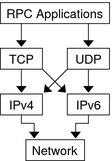| Skip Navigation Links | |
| Exit Print View | |

|
ONC+ Developer's Guide Oracle Solaris 11.1 Information Library |
| Skip Navigation Links | |
| Exit Print View | |

|
ONC+ Developer's Guide Oracle Solaris 11.1 Information Library |
1. Introduction to ONC+ Technologies
4. Programmer's Interface to RPC
5. Advanced RPC Programming Techniques
6. Porting From TS-RPC to TI-RPC
Differences Between TI-RPC and TS-RPC
Creating and Destroying Services
Registering and Unregistering Services
7. Multithreaded RPC Programming
8. Extensions to the Oracle Solaris RPC Library
IPv6 is the successor of IPv4, the most commonly used layer 2 protocol. IPv6 is also known as IP next generation (IPng). For more information, see System Administration Guide: IP Services.
Both IPv4 and IPv6 are available to users. Applications choose which stack to use when using COTS (connection-oriented transport service). They can choose TCP or CLTS (connectionless transport service).
The following figure illustrates a typical RPC application running over an IPv4 or IPv6 protocol stack.
Figure 6-1 RPC Applications

IPv6 is supported only for TI-RPC applications. TS-RPC does not currently support IPv6. Transport selection in TI-RPC is governed either by the NETPATH environment variable or in /etc/netconfig.
The selection of TCP or UDP instead of IPv4 or IPv6 is dependent on the order in which the corresponding entries appear in /etc/netconfig. Two new entries are associated with IPv6 in /etc/netconfig, and by default they are the first two entries of the file. TI-RPC first tries IPv6. Failing that, it falls back to IPv4. Doing so requires no change in the RPC application itself provided that it doesn't have any knowledge of the transport and is written using the top-level interface.